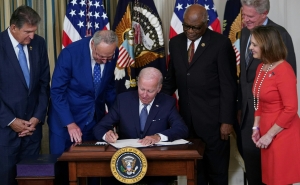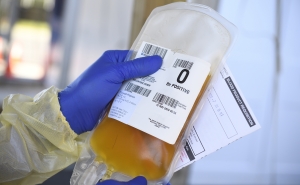Interim Framework for COVID-19 Vaccine Allocation in the United States

A Q&A with a co-author of the new report from the Center for Health Security
Widespread vaccination is the only solution to ending the COVID-19 pandemic.
There are 165 vaccine candidates currently in development around the world with hopes that at least one or more will be safe and effective enough to be approved for emergency use in the U.S.
But initially, this vaccine will be in limited supply. A national plan will be needed to determine how to allocate and distribute this first vaccine, which means prioritizing certain groups. Policymakers will need to take into account medical risk, public health, ethics and equity, economic impact, and logistics to make difficult decisions around who will get vaccinated first.
The Center for Health Security’s new report, Interim Framework for COVID-19 Vaccine Allocation and Distribution in the United States, is an ethical framework to help guide decision making around vaccine allocation. The report lays out a series of three broad ethical considerations to guide policymakers and encourage transparency and feasibility in implementation.
Eric Toner breaks down some of the key points of the report in this Q&A.
This report is mainly geared towards policymakers and technical experts but there’s a broader discussion about equity in terms of a COVID-19 vaccine. What do you think the general public should know about vaccine allocation?
With limited amounts of vaccine available in the first few months after its use is authorized, it is important to use the vaccine first where it will do the most good. That means offering it to those people that are most at risk and those that are most essential to the pandemic’s response.
Can you briefly describe the three broad ethical values that you and your co-authors considered for this report?
- Promoting the common good. This involves limiting the number of deaths at the same time as promoting economic and social well-being.
- Justice, fairness, and equity. This means making sure that everyone who is in a group that is a priority for early vaccination is offered the vaccine. This entails reaching out to some groups that may normally be hard to reach but that are at high risk or are essential workers.
- Legitimacy. This involves how we decide who to prioritize and whether the process will be viewed by the public as having been trustworthy.
The report talks about “promotion of legitimacy, trust, and a sense of community ownership over vaccine policy, while respecting the diversity of values and beliefs in our pluralist society.” Can you talk a little about what this means in terms of vaccine allocation?
In a multicultural society like ours, there are different views on some moral and ethical questions and varying levels of trust in government and other authorities.
For a vaccination campaign to be successful—which means that most people will want to be vaccinated—the public must have trust in the safety and efficacy of the vaccine but also in the people, institutions, and policies behind the vaccine. The broad and diverse public needs to feel that it has had a voice in the policymaking process.
There are two tiers of groups considered “high priority” for COVID-19 vaccination. Can you give some examples of who might fall into these groups?
TIER I
- Those most essential in sustaining the ongoing pandemic response, such as frontline health care workers taking care of COVID-19 patients
- Those at greatest risk of severe illness and death and their caregivers, such as the elderly
- Those most essential to maintaining core societal functions, such as frontline food and transportation workers or school employees
TIER II
- Those involved in broader health provision, such as other health care workers
- Those who face significant barriers to access care if they become seriously ill, such as people who live in remote rural communities
- Those contributing to maintenance of core societal functions, such as public utility workers, warehouse employees, and delivery personnel
- Those whose living or working conditions pose an elevated risk of infection even if they have a lesser or unknown risk of severe illness and death, such as people who work in high-density or high-contact jobs or live in shelters
How might policymakers work with public and private partners to prioritize vaccination of these people?
It's really about how to reach these groups. First, they need to be identified in each community and then public health officials need to reach out to leaders or other trusted members of the groups to enlist them in finding the most effective ways to encourage vaccination. In some cases this might be through employers, in other cases unions or community-based organizations like churches.
Which of these groups might be the hardest to target for prioritized vaccination?
The hardest groups to reach may be marginalized or historically disadvantaged groups that have limited access to health care and limited trust in governments. In these groups it will be especially important to identify and work in collaboration with trusted community leaders.
It’s possible that the first vaccine approved for emergency use is only 50% effective—which is still considered an achievement. How might this affect prioritization?
I don't think it will change prioritization unless the vaccine is especially ineffective in certain groups, such as the elderly.
Low efficacy, however, will likely adversely affect acceptance of the vaccine—people may be reluctant to take a new vaccine that is not very effective.
How is the public’s reckoning around race influencing conversations about prioritization for a COVID-19 vaccine?
There is a lot of discussion of how to address longstanding historic ethnic and racial inequities and how those factor into prioritization and distribution plans. It is very clear that many racial and ethnic minorities are at much greater risk of being infected with the virus and becoming severely ill if they are infected. Special efforts must be made to reach these groups and encourage vaccination.
How soon should policymakers start establishing a vaccine allocation plan?
Policymakers are already working on this in a CDC advisory committee at the National Academy of Medicine and within HHS. Beyond internal planning, however, it is vitally important that they begin now in engaging the public and external stakeholders in the discussions.
What isn’t covered in this report?
What we do not discuss is mandating vaccination of any group. We believe that in the context of a new vaccine, that raises too many issues of personal liberty and is likely to be counterproductive.





